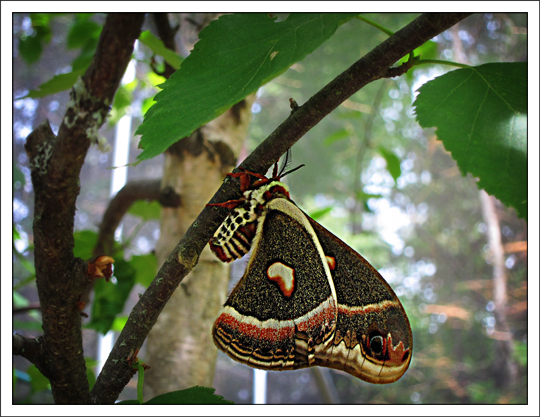Moths of the Adirondack Mountains:
Cecropia Silkmoth (Hyalophora cecropia)
 Moths of the Adirondack Mountains: Cecropia Silkmoth in the Paul Smiths VIC Butterfly House (16 June 2012)
Moths of the Adirondack Mountains: Cecropia Silkmoth in the Paul Smiths VIC Butterfly House (16 June 2012)
| This page is no longer being updated. For an updated version of this material, see: Cecropia Silkmoth (Hyalophora cecropia). |
The Cecropia Silkmoth (Hyalophora cecropia) is a large moth which may be seen in the Adirondack Mountains in upstate New York from late May through July. [1] It is also called the Robin Moth. [2] With a wing span of 11-15 centimeters (4 5/16 - 5 7/8 inches), this is the second largest moth in North America. [3] The body of the Cecropia Silkmoth is red with a white collar and a series of white bands on the abdomen. [4] The wings are dark brown with crescent spots. [5] The Cecropia has rounded wing tips and feathery antennae. There is a vertical stripe on the wing with three color layers: black, white and reddish orange. This distinguishes the Cecropia from the similar Columbia Silkmoth, which lacks the reddish-orange layer on the vertical line. [6]
The female Cecropia lays rows of two to six eggs on the leaves of small host trees or shrubs. Young caterpillars emerge from the eggs in 10-14 days, to feed in groups on leaves. Older caterpillars are solitary. [7] The greenish-blue caterpillar is about four inches long with two rows of red, yellow, and blue spiny tubercles on its body. [8] Caterpillar hosts include maples, cherries, plum, birch, alder, dogwood and willow. [9] The adult Cecropia SIlkmoth does not feed.[10] It lives only for a few weeks; its only purpose is to mate. [11]
The Cecropia Silkmoth's habitats include urban and suburban environments, as well as meadows and fields, scrub, shrub, and brushlands. [12 [13] This insect ranges from Nova Scotia and Maine south to Florida, west across southern Canada and the eastern United States to the Rocky Mountains. [14] The Cecropia Silkmoth has become less common than previously, apparently because of habitat loss, pollution, herbicides and pesticides, and disease. [15] The Cecropia is one of several silkmoth species that are thought to be declining in the northeastern United States. [16]
In 2012, Cecropia SIlkmoths were seen in the northern Adirondacks in late May and early June. [17] In 2012, this insect was present in the Paul Smiths VIC Native Species Butterfly House from the opening on 9 June through 8 July. In previous years, Cecropias were present in the Butterfly House and in the surrounding area until well into July. [18]
References
- Susan Grimm Hanley. Interpretive Naturalist, Paul Smith's College Native Species Butterfly House. Species Logbooks.
- Butterflies and Moths of North American. Species Profiles. Sighting record: 6/16/12
- ENature. Field Guides.
- Project Silkmoth. Cecropia Moth (Robin Moth).
- Project Silkmoth. 2012 Sightings Map.
- NatureWorks. Nature Files.
- Iowa State University. Department of Entomology. BugGuide.
- Insect Images. Cecropia Moth.
- Charles V. Covell, Jr. A Field Guide to the Moths of Eastern North America (Houghton Mifflin Company, 1984), p. 52.
- David Carter. Butterflies and Moths (Dorling Kindersley, Inc., 1992), p. 93.
- David Beadle and Seabrooke Leckie. Peterson Field Guide to Moths of Northeastern North America (Houghton Mifflin Harcourt Publishing Company, 2012), pp. 256-257.
